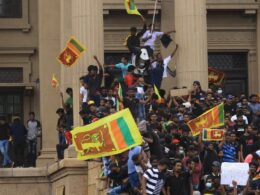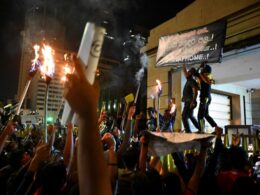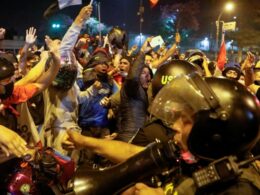Syria’s agony continues unabated. Across the country there are indiscriminate attacks by the Assad regime forces and their militias, bloody sectarian reprisals by the armed opposition, refugee floods and humanitarian disasters.
The second city, Aleppo, is the latest focus of fighting between armed opposition forces and the Syrian army. Since the rebels entered Aleppo on 20 July, many residents have fled for Damascus and Turkey.
The battle for Aleppo is important for both sides. Larger than the capital, Damascus, it is the main economic centre, with an important manufacturing sector. The rebel Free Syrian Army (FSA) advanced on the city trying to capitalise on momentum they believed they made during an assault on Damascus and the bombing of a government intelligence meeting, which killed four generals. The Syrian army is gathering heavy armour and troops on the outskirts of Aleppo and stepping up its offensive.
Like the rest of Syria, Aleppo is made up of a patchwork of religious and ethnic groups. The majority of the city’s population are Sunni Muslims or Kurds. There are also Armenians and other Christians from the Syrian, Maronite and Greek Orthodox churches. Many government employees in the city are from president Assad’s Alawite sect. Until recently Aleppo saw relatively little violence. Now the bloody death-toll across the country, estimated at around 100 a day in July, is set to dramatically rise as the battle for the city is fully joined.
Popular movement
The March 2011 uprising in Syria began as a genuine, popular movement against Assad’s police state, the erosion of social welfare, high levels of poverty and unemployment, and the rule of the rich, corrupt elite. Bashar al-Assad’s dictatorship responded to the wave of mass protests against 40 years of dictatorial rule – widely seen as part of the ‘Arab Spring’ – with vicious repression.
Brutal suppression of demonstrators led some activists to take up arms. The Committee for a Workers’ International (CWI, the socialist international organisation to which the Socialist Party is affiliated) advocated democratically run workers’ self-defence committees that could protect communities and cut across sectarian lines.
At the same time, the CWI called for this to be linked to a programme demanding the end of the Assad dictatorship and for fundamental democratic, social and economic change.
But crucially the mass protests lacked an independent working class leadership. This allowed sectarian and pro-capitalist oppositionist figures to partially fill the political space. Reactionary Gulf regimes, along with Turkey, and with Western imperialist backing, intervened with guns and money for the opposition, political strings attached, of course.
The US, Britain and France have long regarded Assad’s regime as a troublesome obstacle to their imperialist interests in the region. In its place they want to see a pliant, pro-Western administration.
Crucial to their plans is to fundamentally weaken their main foe in the region, Iran.
Tehran is an ally of the Syrian regime. The fall of Assad could also strengthen pro-US Sunni Gulf regimes, while weakening Shia-based Hezbollah in Lebanon and Russian imperialism’s position in the region.
What began as a popular uprising in Syria descended into a civil war, with increasing sectarian dimensions. Working people and the poor pay the greatest price for the failure of the revolt to develop into a powerful, independent movement based on a united working class. The estimated death toll now stands at 20,000. The United Nations (UN) believes that 150,000 people have fled the country.
But the words of concern for the people of Syria from the mouths of Western politicians are just so much hypocritical cant. Only a few years ago, the Bush administration sent ‘terrorist suspects’ to Damascus to be tortured by Assad’s thugs. Now President Obama claims he wants to see Bashar al-Assad’s dictatorship replaced with “democracy”.
Yet with US blessing, two of the US’s closest allies in the region, the reactionary autocracies of Qatar and Saudi Arabia are busily arming and financing the Syrian rebels. They are not interested in bringing democratic rights to Syria any more than the US or Britain. The Saudi regime represses its own Shia minority, while backing reactionary sectarian Salafists in Syria.
The Turkish government, a Nato (US dominated military alliance) member, loudly denounces oppression in Syria. At home, it is suppressing the media and the Kurds, who are pressing their own demands in both Turkey and Syria.
Assad and opposition
However the role of Western powers and reactionary Gulf regimes are no reasons to support the Assad regime. It is not some sort of ‘bulwark’ against imperialism, as some on the Left in the region and beyond portray.
For socialists the alternative was displayed during last year’s revolutions in Tunisia and Egypt, as well as the early promise of the 2011 Syrian revolt. They showed that it is the mass united movement of working people and youth that can remove despots and their regimes, resist imperialism and fight for real social and political change.
While it may only be a matter of time before Assad falls, the conflict shows no sign of a quick ending. “With or without Bashar al-Assad as its leader, Syria now has all the makings of a grim and drawn out civil war,” warns Vali Nasr, an academic and former advisor to Obama’s special representative for Afghanistan and Pakistan (New York Times, 28 July 2012).
While Assad has lost control of parts of Syria and the opposition is buoyed up, claiming the regime’s power is seriously eroding, the conflict is likely to become protracted.
The high profile defection of some military and diplomatic figures, including Riad Hijab the recently appointed prime minister, has given the impression of a regime in slow-motion collapse. Yet Assad shows no sign of standing down.
To date, Assad has shown he has the military power and enough support in Syria, including from many Sunni business people, to keep fighting. But, although it appears unlikely at the moment, the possibility that Assad could be ousted by a palace coup cannot be ruled out.
While the opposition has made some ground and is now reportedly using heavy weaponry, it is divided “among some 100 groups without clear political leadership”, according to Vali Nasr.
Moreover, the reactionary character of the largely Sunni-based, pro-big business Syrian National Council, which is linked to the Free Syrian Army and their Sunni-elite Gulf backers, means that many of Syria’s Alawite, Christian and Kurdish minorities, as well as some Sunnis, fear what would follow Assad’s overthrow.
The summary execution of unarmed pro-regime fighters by opposition militias in Aleppo, widely viewed on YouTube, will only deepen the fears of Syria’s minorities.
Jihadi organisations are reportedly establishing a foothold in the east of the country, including al-Qaida group, Jabhat a Nusra (Solidarity Front). Foreign jihadists have entered Syria from Turkey, the Caucasus, Bangladesh and the Gulf Arab states, which is helping to stir up divisions within the opposition leadership.
Many of these fighters are battle-hardened veterans of the conflict in Iraq during US occupation. The jihadists in Iraq are, in turn, emboldened by events in neighbouring Syria. The al-Qaida-linked Islamic State of Iraq killed hundreds in July, alone.
Sectarian conflagration
Even if Assad decided to leave office or was removed by his own ruling clique, his military machine, dominated by the Alawite sect, and its allied sectarian militias, could fight on. Syria could face the terrible prospect of breaking up into ethnic enclaves, like the former Yugoslavia, bitterly fighting over territory for years. This would resemble a re-run of the Lebanon’s civil war (which lasted from the mid-1970s to the early 1990s – up to 200,000 died) but on a greater scale. An added horror would be the current regime’s chemical and biological weapons being deployed.
A sectarian conflagration would most likely embroil other countries in the region. Turkey, Iran, Israel and the Gulf States could be drawn into the maelstrom. The Syrian conflict has already spilled over into Lebanon, where the Assad regime has support from Hezbollah, which is part of the coalition government.
The Syrian army has shelled Lebanese villages. Fighting between Sunni and pro-Assad Alawites in the northern Lebanese city of Tripoli and other areas has left scores dead. While the main political forces in Lebanon want to avoid an escalation of Sunni and Shia clashes, regular shootings and kidnappings in Beirut have raised fears of a slide towards sectarian conflict.
Western intervention
While the US is reportedly concerned about the Syrian opposition – the White House remains ‘haunted’ by memories of the catastrophic fall-out from its backing of the Mujahadeen guerrillas during the 1980s war in Afghanistan – the Western powers are concentrating on supporting and aiding the Free Syrian Army and other armed oppositionists. They do this primarily by enforcing sanctions against Damascus and by giving Gulf States the green light to arm and fund the opposition and for Turkey to provide logistical support.
The White House is also taking direct, covert action to support Assad’s armed opponents. According to a Reuters news agency report (1 August 2012), president Obama signed a secret order earlier this year authorising US support for the armed opposition, including the deployment of the CIA and other US agencies. This led to “noticeable improvements in the coherence and effectiveness of Syrian rebel groups in the last few weeks”.
Tory foreign secretary William Hague recently confirmed that Britain is also giving covert support to anti-Assad forces.
The US and other Western powers hope such actions will eventually see the downfall of Assad. However some pro-Western commentators warn that Assad’s fall would be a Pyrrhic victory. It would just be the beginning of even greater conflict in Syria and the region.
They counsel the White House to work towards a ‘transitional plan’, to create a post-Assad power-sharing arrangement that “all sides” can agree on. This would entail a UN ‘peace-keeping’ force. To reach such an agreement would mean involving Russia and Iran, Vali Nasr believes, who may come to see the writing on the wall for Assad.
Even if such a scenario was eventually cobbled together after much more bloodshed and destruction, it would not bring democracy, stability or prosperity for Syria.
It would see the imposition of a Western military-dominated regime, involving reactionary pro-capitalist and sectarian-based forces. It would be no answer to the needs of the Syrian masses and working class.
Working class
The working people and the poor in Syria face a desperate situation and the real danger of being engulfed in ethnic and sectarian warfare. Socialists everywhere must do all they can to help the workers of Syria to build class unity to resist and overcome these divisions.
In the current situation, these are herculean tasks. Yet there is no other way to successfully unite the masses to overthrow the brutal Assad regime, to oppose the meddling of local reactionary states and imperialism, and to win real democratic rights and fundamental social and economic change.
Despite their terrible plight, the Syrian masses are not alone. Their fate is inextricably linked to the ongoing revolutionary movements in Tunisia, Egypt and elsewhere throughout North Africa and the Middle East.
There have been 18 months of revolution and counter-revolution and the process is far from over.
While sectarianism is on the rise in Egypt, so too is class struggle, as a new wave of strikes and occupations sweeps the country. Egyptian workers are not waiting for the new government to improve their lives. They are building their own organisations and taking independent action. This is the model to follow!
By practically and politically linking up the class interests of workers in Syria, Egypt, Tunisia and throughout the region, workers’ mass organisations, such as independent trade unions and new mass parties, can be built.
By basing itself on a united workers’ programme with socialist policies for fundamental change – democratic workers’ control and management of the economy to transform living conditions, creating jobs with a living wage, free quality education, health and housing and so on – such a movement would inspire workers and youth all across the region to unite to kick out the tyrants and imperialism.
This would lead to a struggle for a voluntary and equal socialist confederation of the Middle East, in which the rights of all minorities would be guaranteed.












